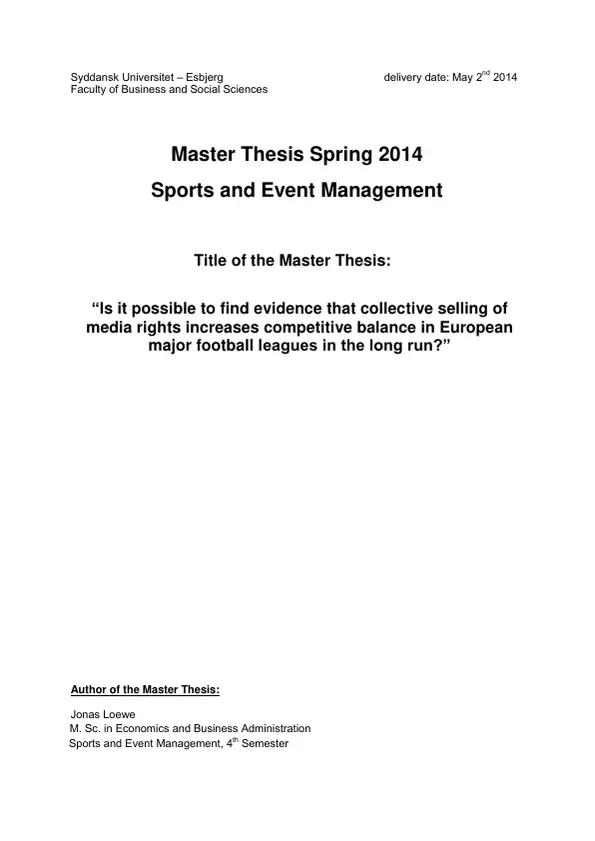Current discussions in the business of professional football are dealing frequently with the question if competitive balance is decreasing in the European major leagues. Clubs like the FC Barcelona or FC Bayern München were dominating on a national and European level in recent years. In professional sports a positive helix between financial and sporting power exists. Sporting success implies financial success which can be reinvested in the sporting strength, hence leads to even more competitive power. The key driver for the underlying financial success consists of the revenues generated by selling the clubs’ media rights. Two different systems of selling these rights exist, a decentralized and a centralized one. The aim of this paper is to investigate if the selling system of the media rights has influence on the competitive balance in the league.
Many different tools to measure competitive balance in team sports exist. For the underlying analysis the Ratio of Standard Deviation, the Concentration Ratio 2 and the Concentration
Ratio 5 have been applied. The final rankings of the recent 30 seasons from 1984 to 2013 of six European football leagues have been investigated, the English, Spanish, German, Italian,
French and Portuguese league. The data for the analysis was disposable on the World Wide Web. The leagues were analyzed with each measurement tool. The results were presented
and evaluated in different steps. In the first step the results of each league were calculated for each measurement tool for the entire investigation period. In the second step the results
were sorted and subsequently summarized to one final ranking of competitive balance. By means of this final ranking and the individual analysis results of the leagues, the author tried
to cluster and evaluate these findings referred to the media rights selling system.
Out of the analysis it can be stated that leagues with an individual TV rights selling system show a lower level of competitive balance by trend. This statement can be emphasized by the created five hypotheses which all point in the direction that collective selling of the TV rights increases competitive balance. Two out of these five hypotheses can be confirmed to a large extent out of the investigation and one can be confirmed from a theoretical point of view. The lasting two hypotheses can neither be confirmed completely out of the investigation results, nor rejected.
Inhaltsverzeichnis (Table of Contents)
- Abstract
- Table of content
- List of figures
- List of tables
- List of abbreviations
- 1 Introduction
- 2 Target markets
- 2.1 European professional team sports market
- 2.2 European television market
- 2.2.1 Broadcasting in sports
- 2.2.2 Legal background
- 3 Theoretical frameworks
- 3.1 Multi-sided markets
- 3.2 Analysis dimensions
- 3.2.1 Theory of competitive balance
- 3.2.2 Theory of media rights selling systems
- 3.2.3 Theory of revenue sharing systems
- 4 Status quo
- 4.1 Competitive balance
- 4.2 Media rights selling systems
- 4.3 Revenue sharing systems
- 4.4 Influence factors
- 5 Research design
- 5.1 Method discussion
- 5.2 Hypotheses
- 5.3 Design of the analysis
- 6 Presentation and evaluation of the analysis
- 6.1 Results of the RSD
- 6.2 Results of the CR5 and CR2
- 6.3 Statistical analysis of the results
- 6.4 Evaluation of the hypotheses
- 7 Conclusion
Zielsetzung und Themenschwerpunkte (Objectives and Key Themes)
The primary objective of this Master Thesis is to investigate whether collective selling of media rights contributes to increased competitive balance in major European football leagues over the long term. The thesis explores this question through the analysis of data from six European leagues over a 30-year period.
- Competitive Balance in European Football Leagues
- Media Rights Selling Systems (Decentralized vs. Centralized)
- Impact of Media Rights on Financial and Sporting Power
- Analysis of Competitive Balance Measurement Tools
- Influence of External Factors on Competitive Balance
Zusammenfassung der Kapitel (Chapter Summaries)
The thesis begins by introducing the research question and outlining the key themes of the study. Chapter 2 provides a detailed overview of the target markets, including the European professional team sports market and the European television market, with specific focus on broadcasting in sports and legal background. Chapter 3 delves into the theoretical frameworks relevant to the research, such as multi-sided markets, competitive balance, media rights selling systems, and revenue sharing systems.
Chapter 4 presents the current status quo regarding competitive balance, media rights selling systems, revenue sharing systems, and influence factors in European football leagues. Chapter 5 outlines the research design, method discussion, hypotheses, and the design of the analysis. Chapter 6 presents and evaluates the results of the analysis, including the results of the Ratio of Standard Deviation (RSD), Concentration Ratio 5 (CR5), and Concentration Ratio 2 (CR2) measurements.
Schlüsselwörter (Keywords)
This Master Thesis explores the relationship between media rights selling systems and competitive balance in European football leagues. Key concepts include competitive balance, media rights, decentralized and centralized selling systems, revenue sharing, financial and sporting power, and analysis tools like the Ratio of Standard Deviation, Concentration Ratio 5, and Concentration Ratio 2.
- Arbeit zitieren
- Jonas Loewe (Autor:in), 2014, Collective selling of media rights as instrument for competitive balance in European major football leagues, München, GRIN Verlag, https://www.grin.com/document/283662



